|
Monday, May 11, 2009
Progress Notes
Saturday, May 02, 2009 was Docent training day at the museum which was given by museum director, Nancy Thompson, to 27 volunteers from the Miller County community who graciously have offered to help host our museum throughout the coming summer (photo 01).
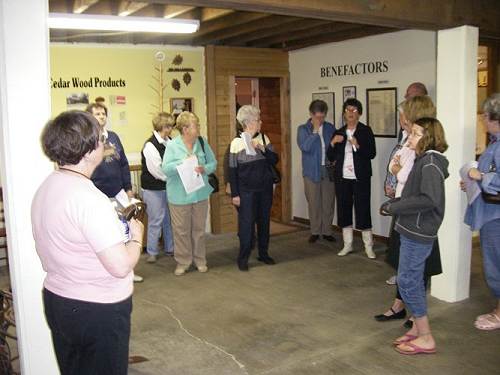
01 Docent Day Volunteers Nancy informed the group of various ways to enhance the interest and enjoyment of the guests who honor us by visiting our new museum over the next summer season. Nancy told us that the word “Docent” means teacher so she pointed out some important informational items of significant historical interest the docents could emphasize for our guests. After a brief instructional period she took the group on a tour of the museum (photo 02).
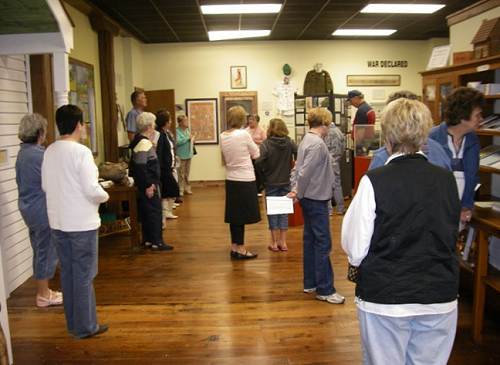
02 Tour of Museum We are very appreciative of the willingness of members of the entire Miller County community to volunteer their time to help us at the museum this season.
One couple who attended the session was Ellis and Jackie Bray of Eldon (photo 03).
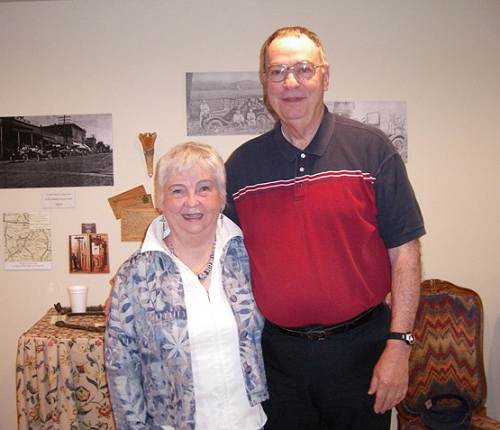
03 Ellis and Jackie Bray We were delighted to receive as a gift a painting by Jackie made of the old Lupardus cabin now located on our museum grounds (photo 04).
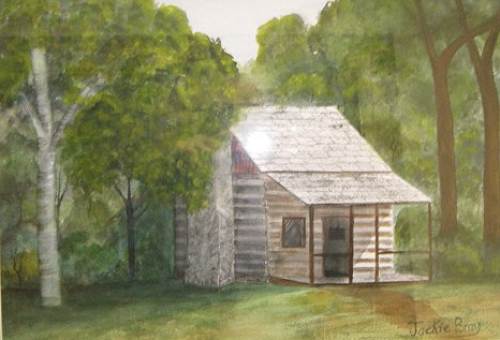
04 Lupardus Cabin Painting by Jackie Bray Jackie painted the cabin while at an art show two years ago held at the museum. Inspired by the painting created by his wife, Ellis gave us a poem he composed about the cabin (photo 05).
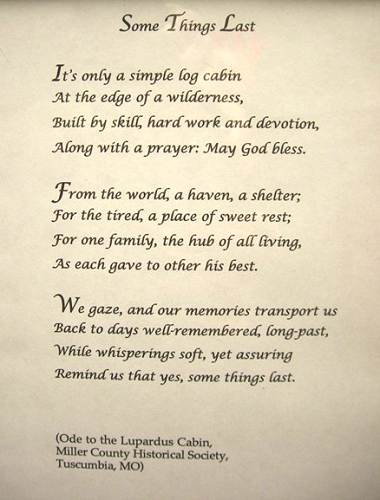
05 "Some Things Last" Poem Ellis also is our expert about the history of the artifacts left here by the Native American population which once inhabited this area. Recently, he identified and labeled all the Native American items in our collection. These were organized by volunteer Diane Berkbigler into a very attractive and interesting display.
Also visiting our museum May 2 was Peggy Trachi of Oregon who donated some topography maps given her by her grandfather, Lafe C. King, who was Miller County Treasurer in the 1940’s (photo 06).
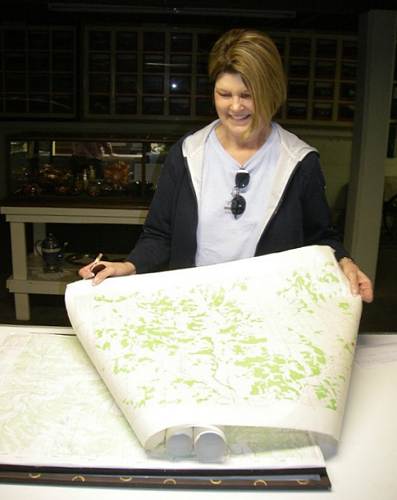
06 Peggy Trachi with Topography Maps Peggy is related to the Miller County Edwards family through her mother, Lois, who was the daughter of Joe Edwards and granddaughter of George Edwards of Tuscumbia. Peggy has written several articles about her Edwards family. One of those articles, about her uncle Gene Edwards, I copied into a previous edition of Progress Notes.
We are grateful for all the time Peggy gives to helping us preserve Miller County history.
In the next photo Elva Steen, who is our museum quilter, is sitting in front of a quilt hanging on the wall behind her which is the oldest quilt in our collection dating back to the Civil War (photo 07).
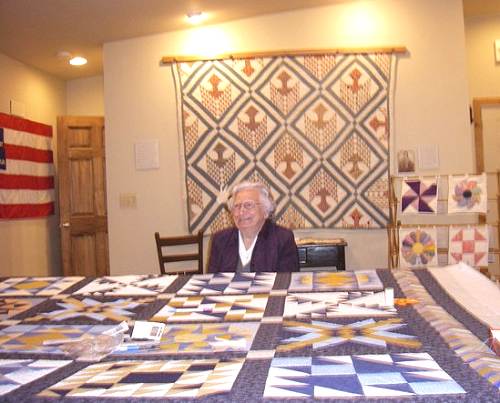
07 Musuem Quilter Elva Steen and Oldest Quilt It was made by Frances Jane Williams, daughter of John Williams Jr. of Iberia (photo 08).
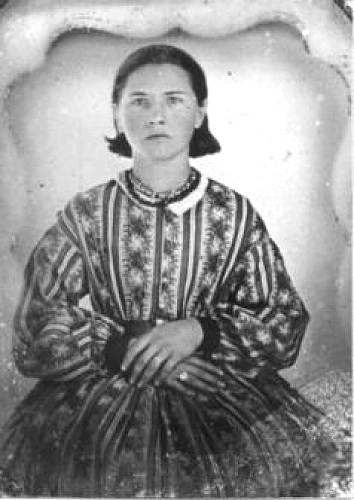
08 Francis Williams Pemberton - 1866 Here is the story of the quilt as sent me by Nancy Thompson, our museum director, who is a direct descendent of John Williams:
“When John Williams returned from the Civil War, he found his log cabin was destroyed and learned that his third oldest son, John Riley, had died in a Yankee uniform. If that was not enough, his daughter Francis ("Fanny") married James Lewis Pemberton (photo 09). This was the same man who enlisted in the Union army with John Riley. John's dear Fanny had married a damn Yankee!
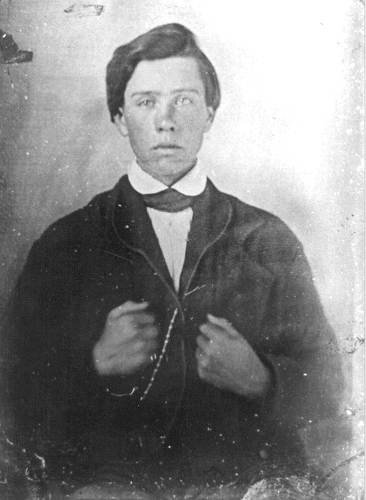
09 James Lewis Pemberton - 1866 James Lewis and Fanny were married in 1866 after James Lewis returned from service in the Civil War. They had courted before he enlisted. As he was leaving to join the Union army he tried to kiss her, but she slapped him away! Years later Fanny told her granddaughter: "I sent your grandfather to war with his cheeks burning. Never let a man hold your hand until you are engaged. Never let him kiss you until you are married."
The obituary of Frances Jane Williams Pemberton offers more information about her:
Obituary: Iberia Sentinel May, 1926
Frances Jane Williams
Frances Jane Williams was born in Graves County, Kentucky, June 20, 1845, and died May 29, 1926, at the age of 80 years, 1 month and 8 days. At the age of thirteen she came with her parents to Miller County, Missouri.
On March 1, 1866, she was married to James Lewis Pemberton. To this union eight children were born--three girls and five boys. All are still living except the oldest girl Sarah, who died in infancy.The others are: Mrs. D.G. Wall, John, Pressie, Wade and Mrs. R. C. Casey, all of Iberia; Elbet of Taney County, and Wilbert of Los Angeles, California. Her husband also survives, but was unable to be present at the time of her death, as he had undergone an operation in St. Louis only a few days before. She is also survived by one brother, James Williams.
Funeral services were held in the yard of Mrs. Pemberton's home, Sunday afternoon, at three o'clock. Rev. Holt conducted the funeral services and the body was conveyed to the Williams Cemetery by Adams & Casey, undertakers.
Card of Thanks: We wish to express our sincere thanks to our friends for the kindness shown us during the sickness, death and burial of our wife and mother--James Lewis Pemberton and Children.
And further information is found in the obituary of her husband, James Lewis Pemberton:
Obituary: Iberia Sentinel, December 1931
James Lewis Pemberton, one of our county's best citizens, died Wednesday, December 16, at the old Pemberton homestead, west of Iberia. Mr. Pemberton, who was the father of a large family of children and held in highest regard by neighbors and friends, was 86 years old at the time of his death. He had often said that he wished to die on the old home place, and this wish was granted him, for he peacefully passed away there.
He was united in marriage to Miss Fannie Williams. She passed away four or five years ago, but there are seven children who survive them. They are John, Press, Elbert, Wade, Mrs. D.G. (Mahala) Wall and Mrs Ray (Oma) Casey of Iberia, and Wilbert of San Antonio, Texas.
Mr. Pemberton was a member of the Baptist church. Funeral services were conducted at the home Friday by Rev. Holt and burial was at the Williams cemetery, three-fourths mile from the Pemberton home. Fannie and James are both buried in the Williams Cemetery.
Readers may find it interesting to know more about Francis (Fannie) Jane Williams Pemberton.
A descendent of James Pendleton and a great great grandson of John Williams (father of Francis), Andrew J. Pemberton (photo 10), has written a short story of the Williams family.
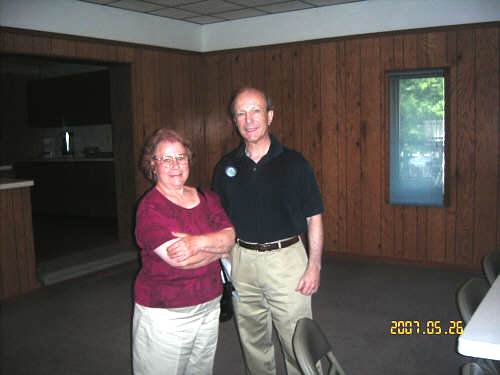
10 Glyna Nickels and Andy Pemberton Andrew (Andy) is the son of Don Pemberton (photo 11), who is a great grandson of John Williams and a grandson of James Pemberton.
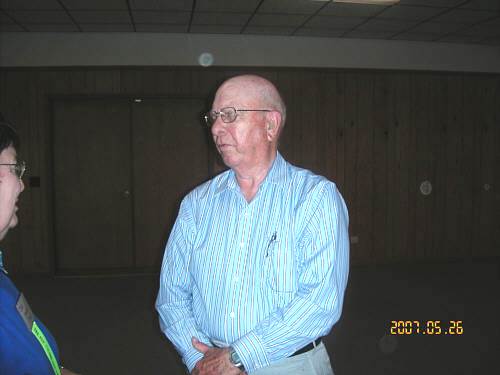
11 Don Pemberton This story and other information about the Williams family can be found on Andrew’s website:
http://home.comcast.net/~ajpem/Scripts/Williams_Cemetery_Page_1.htm
For continuity I will copy from Andrew’s website the story he has written about John Williams and Francis his daughter, the maker of the quilt hanging today in our museum:
John Williams
Andrew M. Pemberton; Great Great Grandson of John and Mahala Williams
Central Missouri, Summer 1859
The rider reigned in his horse at the top of the steep hill. From there John Williams could see the land that would be his family’s new home. Prairie grass swayed in the wind. Trees lined the banks of the streams. The sight thrilled him. They had made it! He felt a great worry lifted from his shoulders. Ten wagons creaked up the trail behind him carrying family and friends. It had been a hard trip from their former home in central Kentucky to these foothills of the Ozark Mountains in Missouri.
Before John was born his father had moved his family from North Carolina to Kentucky. Now, four decades later, John left that Kentucky home and headed even further west into Missouri. It was not an easy decision to uproot his family. It is difficult to leave friends and familiar surroundings. They may never be back. But the farm in Kentucky was not enough to support his growing family. John’s two older sons, Wade and B.B. were old enough to marry. When that happened they would need their own land to support their families. Nearby land in Kentucky was worn out or too expensive. In order to find enough good land they would need to move further west into less settled Missouri. John’s plan was the same as his father’s 40 years earlier: sell expensive land, head west, then buy more land for less money.
The plan worked. In Missouri John found new, fertile land and there was enough of it for all of them. But getting there was a challenge. All their belongings were packed into wagons meant for working a farm. At night they slept on the ground under the wagon or in a tent. They crossed two great rivers; the Ohio and the Mississippi. The land they crossed was new to them. The people were strangers.
John especially worried about his wife. Mahala Barton Williams had become pregnant before they left Kentucky. Riding a stiff, wooden wagon over rutted trails is a jarring experience under normal circumstances. It was especially difficult for her.
From her wagon Mahala saw her husband stop further up the trail. Earlier that morning he told her they were getting close to their new land. Could this be it? Was the journey finally over? She ached from the travel. This trip was not a pleasant thing, but it would end. Childbirth was not the most pleasant thing either, but it ended and then there was great joy. Mahala did not dwell on the discomforts of the trip, she focused on the new life her family would have in Missouri.
Mahala was 42 years old, the same age as her husband. She had given birth to nine children already, ranging in age from 8 to 22. One more coming. She knew women who had problems bearing children. She even knew of some who had died in childbirth. That happened according to God’s will. It was not something to worry about. Better to think about the baby’s beautiful face looking up at you.
She glanced back at the sections of her bed stored in the wagon. She had insisted they bring it with them even though it was difficult to find the room. Soon John would fit the pieces back together and she would be sleeping on it instead of the hard ground. Later this summer she would bear her tenth child on that bed.
The wagon train wound its way down the hill and across the valley to the new land. The tiresome journey was over. Now they could start their new life.
Trees were felled. A log cabin was built. Mahala slept on her own bed in her new home. Several acres of prairie grass were plowed under. Next year, they would make crop on this cleared land.
By August 4, 1859 the baby was ready to come. The delivery was not easy. But, there were smiles all around when the new baby cried. Mahala was not in such good condition. She suffered a great deal. Shortly afterward she died. John named the infant girl Mahala to keep her mother’s memory alive.
A newborn baby needs mother’s milk. But her mother was dead. Where would the mild come from? Sometimes another nursing mother could feed a second baby. But, in this thinly populated area none could be found. A cloth dipped in sugar water and pressed to a baby’s lips helped. But, it only stopped the crying. It was not enough. Four weeks later baby Mahala died.
In his grief John buried his wife and baby on a hillside a short distance from their home. John wanted to be able to look out at the graves through a window in the log cabin. He never re married.
Two years later in 1861 the Civil War erupted. Duty required that men serve their country. So John and his adult sons Wade and B.B. volunteered for service in the Confederate army. Taking their own horses and carrying their own guns they rode to Springfield, Missouri to enlist in the 3rd Battalion Missouri Cavalry, CSA in January, 1862. When spring came their unit was ordered east of the Mississippi River to join the main Confederate forces in the region. The 3rd Battalion Missouri Cavalry (dismounted) was part of the renowned “Missouri Brigade” which fought in most of the major battles in the western theater of the Civil War. On May 16, 1863 B.B. was killed during the Battle of the Champion Hill outside Vicksburg, Mississippi. Then in November, 1864 Wade fell in the bloody Battle of Franklin in Tennessee (photo 12).
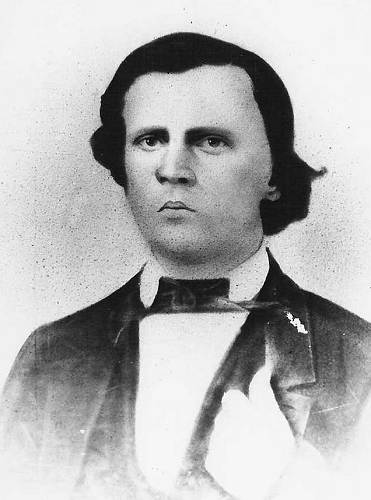
12 Wade Alexander Williams John suffered the agony of seeing two sons die, but he survived the war.
By late 1864 the next oldest son, John Riley, was old enough to fight. So he and his best friend, James Lewis Pemberton, enlisted….in the Union Army! In Missouri and the other border states families were often divided in their loyalties. On March 5, 1865 John Riley died of camp disease while bivouacked outside St. Louis. Just a few weeks later the war ended when Confederate General Robert E. Lee surrendered the Army of Northern Virginia to Union General Ulysses S. Grant at Appomattox Courthouse on April 9, 1865.
Toward the end of the war bushwhackers raided John’s farm. They came to kill adult males and destroy homes. The only son left at the farm was young James. He was just a teenager, but his life was in danger. As the raiders came into view, James climbed out a back window of the cabin. He ran into the woods before he could be seen. The log cabin was destroyed, burned to the ground. But they did not find James. He survived unhurt.
When the war ended John yearned to return home. But, immediately after the war it was dangerous for southern soldiers to return to Missouri. Local marauders might kill them. Any one sheltering them was also in danger. So John stayed with his brothers in Arkansas and made one or two crops of tobacco.
After a period of time John judged it safe to return home. Much had happened during his absence, very little of it good. He found his log cabin was destroyed and learned that his third oldest son, John Riley, had died in a Yankee uniform. If that was not enough, his daughter Francis (“Fanny”) had married James Lewis Pemberton. This was the same man who enlisted in the Union army with John Riley. John’s dear Fanny had married a damn Yankee!
In the space of a few years John had lost his wife and infant daughter, watched two sons die in battle, learned that a third son had died of camp disease, found his house burned to the ground and the cause he believed in defeated. After suffering such devastating losses what could a person do?
John did what needed to be done. He prepared the fields. He planted crops. He rebuilt the house bigger and better. In short, he resumed the hard, but peaceful life of a farmer. Finally, he lived the life that people are seeking when they make great journeys and fight terrible wars.
As time went by John reconciled to the marriage of Fanny and James Lewis. He lived with them in his later years. He was 80 years old when he died on May 27, 1895. John was laid to rest in the hillside next to his wife and baby. Years later, after living full lives Fanny and James Lewis joined her parents in the same hillside graveyard.
Mahala William’s gravesite is in the Williams Pemberton Cemetery. Modest in appearance, the cemetery is rich in history. In it are the graves of Williams and Pembertons, Bartons, Steens, Walls and more. It is located in Miller County, Missouri between Iberia and Brumley near Highway 42 and Barren Fork Creek. The cemetery is surrounded by private property.
Thanks Andy for this very interesting history of the John Williams family and especially that of Francis Jane Williams Pemberton, the one who made the quilt now hanging in our museum. Andy’s mother, Barbara Pemberton, who passed away slightly over a year ago, was a meticulous genealogist and she is the one in the family who had documented the facts relating to the story her son, Andy, told above.
Here is a recent photo of the Williams Pemberton Cemetery (photo 13).
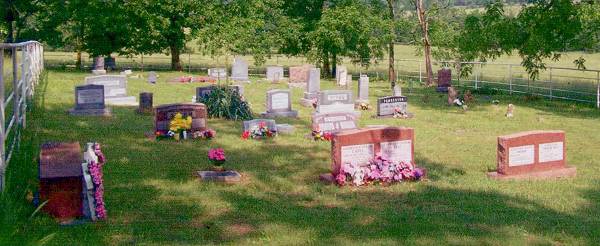
13 Williams Pemberton Cemetery And here are the tombstones of John Williams (photo 14), Mahala, wife of John Williams (photo 15), and Mahala, daughter of John and Mahala Williams (photo 16).
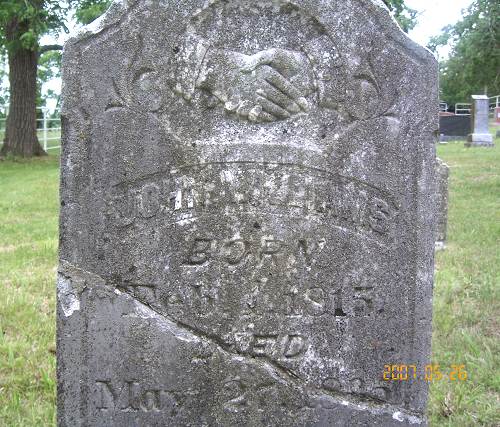
14 John Williams Headstone
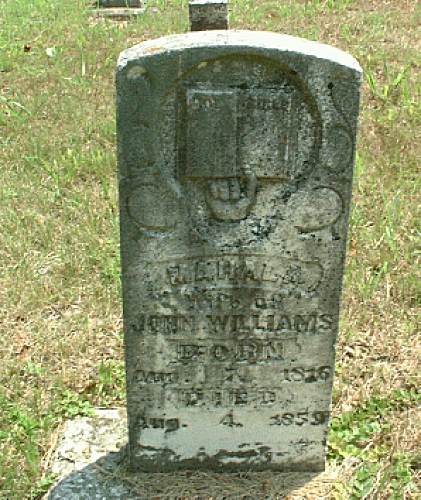
15 Mahala, Wife of John Williams
Born Aug. 7, 1816 - Died Aug. 4, 1859
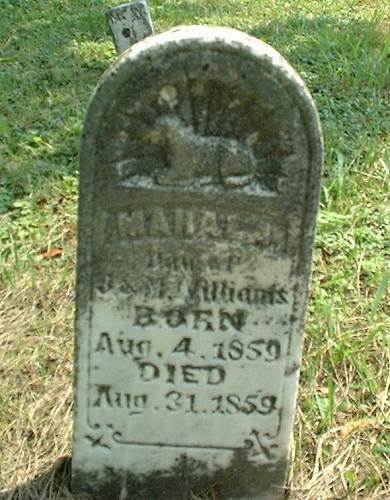
16 Mahala, Daughter of John and Mahala Williams
Born Aug. 4, 1859 - Died Aug. 31, 1859 For more information about the John Williams/Pemberton families of the Iberia area, you might want to attend the annual Williams/Pemberton Cemetery meeting coming up this next May 23. Copied below is a recent announcement in the Autogram Sentinel about the meeting:
The annual Williams/Pemberton Cemetery meeting and potluck dinner will be held at the Iberia VFW Hall on Saturday, May 23, from 12 noon to 3:30 p.m.
Special for the day will be the famous Steen soup and Pemberton pie. Bring a dish to compliment the soup and pie.
Featured speaker will be Donald D. Pemberton, a great-grandson of John Williams Jr. He will present a program which will focus on the life of John Williams Jr. from 1858-1895.
If you wish to attend this interesting family meeting and learn more about the persons who are buried at the Williams family cemetery, please RSVP and contact Mrs. Maloney at the following email address: dana_maloney@msn.com.
The Williams family has donated many other important items to our museum through the years. One of these is an old loom which was made by John Williams for his family’s own use. Years later the Williams family donated it to the Iberia Academy which at that time was teaching the art of weaving. After the academy closed the loom was returned to the family which in turn donated it to our museum when it began operation in the 1970’s. We will be demonstrating how this old loom works at our Grand Reopening this next Saturday, May 16 beginning at 1:00 p.m. You won’t want to miss our weaver lady, Lola Howser of Barnett, who has woven more than one hundred rugs on her own loom at home. She will be assisted by her granddaughter, Samantha Richardson also of Barnett. Here is a photo of Lola and Samantha weaving on the old loom recently getting it ready for “show time (photo 17)!”
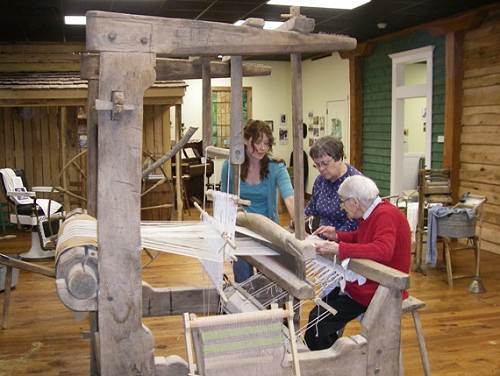
17 Williams Loom with Samantha Richardson, Nancy Thompson and Lola Howser Another very interesting Williams family story is associated with the smaller of the two log cabins we have on our museum grounds. Both cabins are located close to each other (photo 18).
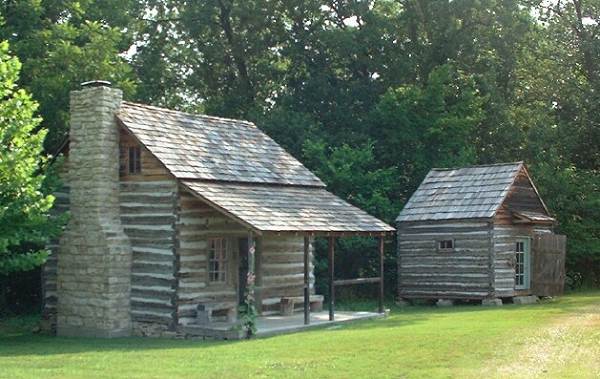
18 Log Cabins The larger cabin is the Lupardus cabin. The smaller cabin was donated to the museum by members of the Williams family in the 1990’s (photo 19).
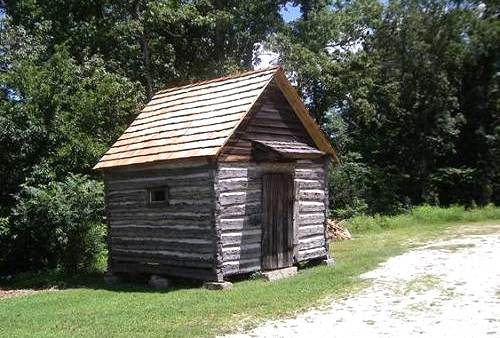
19 Williams Cabin on Museum Ground If you want to read more about the history of this cabin refer to a previous editon of Progress Notes from last August 11.
You will need to scroll part way down the page to get to the story of this small cabin as told by Sue Steen Cates, a great great granddaughter of John Williams.
If you also want to read the story of the Lupardus cabin, the larger of the two, go to this URL on our website:
http://www.millercountymuseum.org/homesteads/lupardus.html
The Williams family and James Pemberton family lived only a short distance from each other. The Williams house no longer is standing having burned some fifty years ago. Here is a photo of it when the Frank Steen family lived there (photo 20):
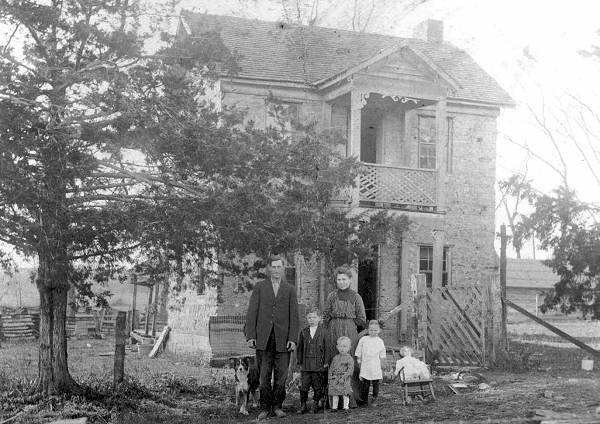
20 Williams Home - Frank, Ellie, Waldo, Vergie and John Steen - 1913 Frank was married to Ella Wall, who was a granddaughter of John Williams. It was located only a short distance away from the Williams Pemberton cemetery.
The James Pemberton home is still standing although in some disrepair. Some time ago I walked around it and took a number of photos which I will post here. Lewis Wall, Iberia resident who has been a long time friend of our museum, took me over there one day. We were joined by Donald Keeth, brother to Verna Pemberton, who lives nearby. Here are the series of photos of the Pemberton home (photos 21 thru 29):
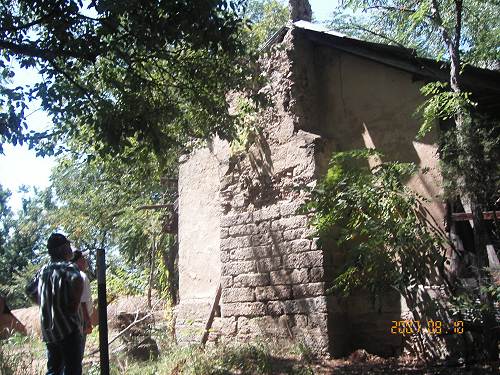
21 James Pemberton House
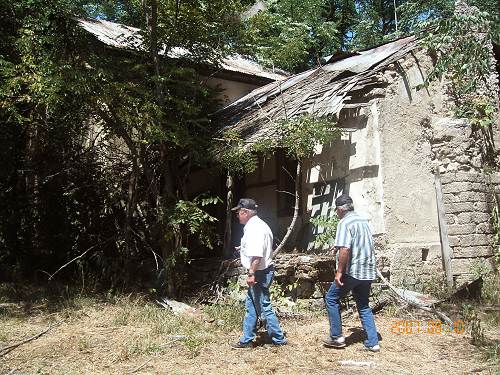
22 James Pemberton House - Lewis Wall and Donald Keeth
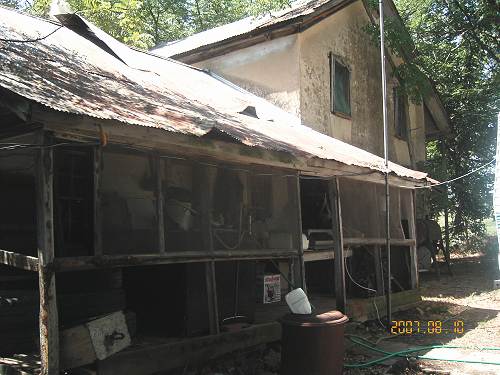
23 James Pemberton House
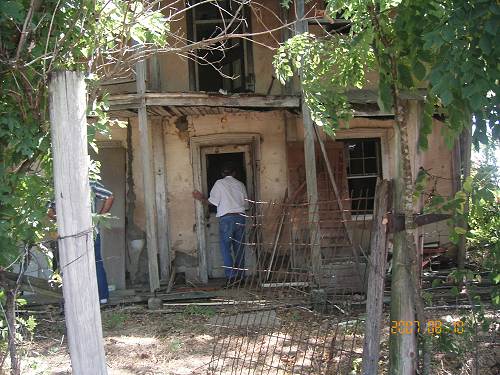
24 Front of James Pemberton House
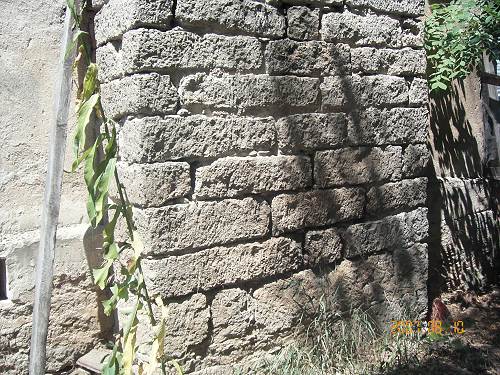
25 Cut Stone Chimney - James Pemberton House
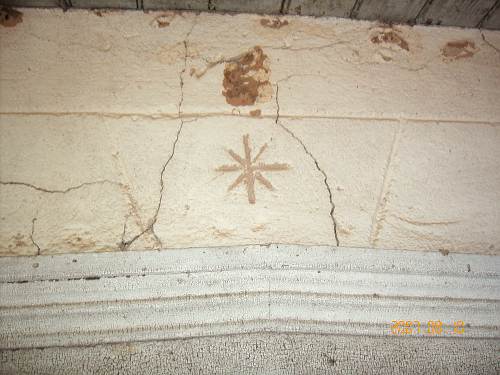
26 Decoration above Door - James Pemberton House
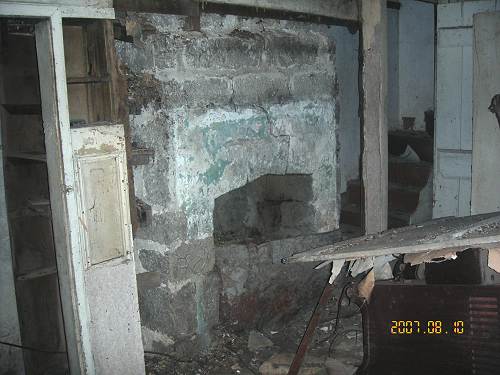
27 Fireplace - James Pemberton House
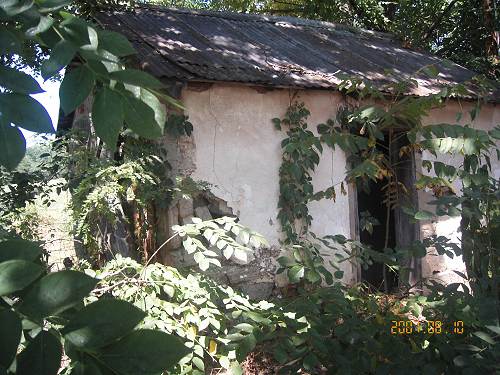
28 Spring House - James Pemberton
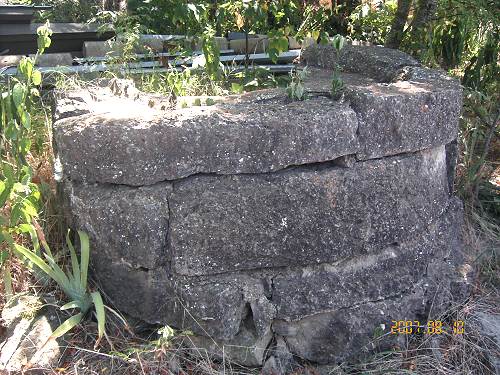
29 Curved Stone around Spring In the courtyard of the home is a large Kentucky Bean tree (photo 30).
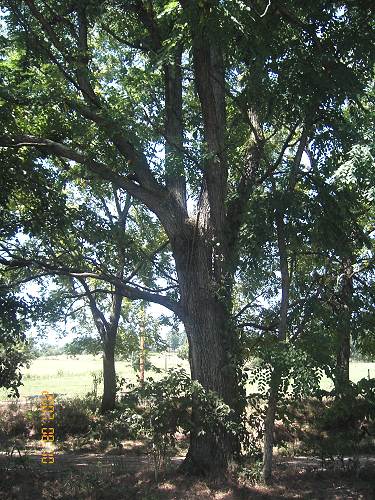
30 Kentucky Bean Tree
This coming Saturday, May 16 between 1:00 p.m. and 3:00 p.m., is our “Grand Re-Opening Day.” To celebrate we have planned several events to be held both outside as well as inside the museum building. These include a taffy pull provided by the New Hope Church, rope making, tie whacking, old time country music by the Joe Jeffries group, weaving demonstrations, and tours of the museum where over the winter we have put in place many new exhibits. The program begins at 1:00 p.m. with a bell ringing of the old Tuscumbia Presbyterian Church, recently returned to our community by the College of the Ozarks where it had been preserved in safekeeping for more than thirty years (photo 31).
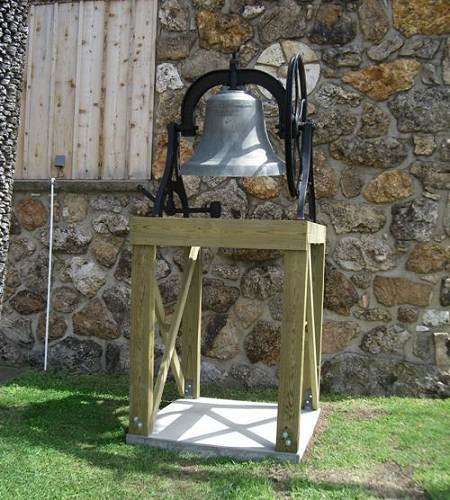
31 Presbyterian Church Bell You can read the story of the return of the bell on this previous edition of Progress Notes.
A short program will follow the bell ringing featuring Presiding Miller County Commissioner Tom Wright, State Representative Rodney Schad, State Senator Carl Vogel, and U.S. Representative Blaine Luetkemeyer. A flag raising ceremony also will be presented of American and Missouri flags which Rodney Schad has arranged for us to have.
Just this week we were putting up the flag pole to get ready for the flag raising (photo 32).
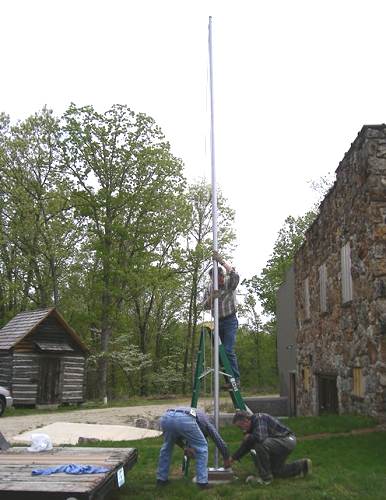
32 Placing Flag Pole - Brice, Jim and Carl In the photo are pole raisers Brice Kallenbach, Jim Clark on the ladder, and Carl McDonald. We are very grateful to the Kallenbach family for providing the funds for the pole and to Brice Kallenbach especially for making all the arrangements for acquiring the materials and making the pole. Other preparations included the painting of the outside doors by Jim Clark (photo 33).
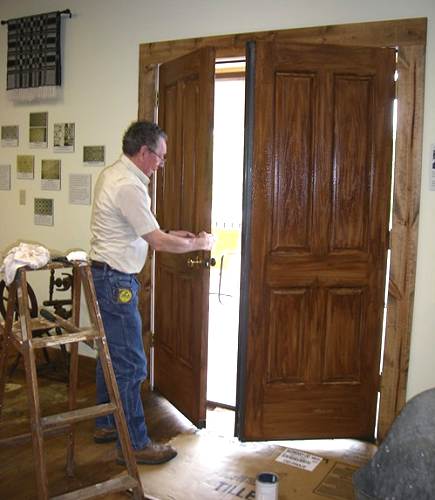
33 Jim Clark staining Doors
Another event Saturday, May 16 in Tuscumbia is an open house at the J.R. Wells home located about three miles north east of Tuscumbia on Highway 17 (photo 34).
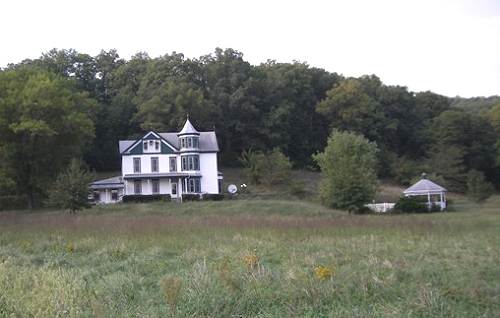
34 J.R. Wells Home - 2008 This is a wonderful time for visitors to attend not only the festivities at the museum Grand Reopening but also to visit a famous historic landmark home in Tuscumbia. The home will be open Saturday afternoon and will feature a special guest appearance in the early afternoon by Roy and Joyce Sone of Jefferson City, who lived in the home in the early 1960’s (photo 35).
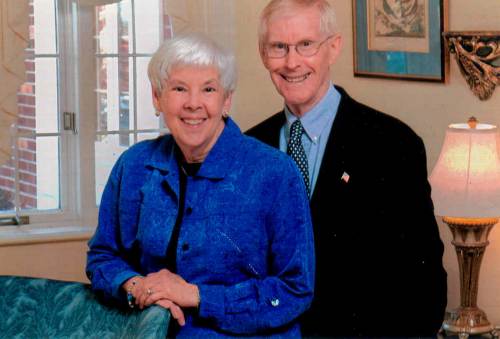
35 Joyce and Roy Sone Roy is the grandson of J.R. Wells (photos 35a) and can give very informative tours of the house and grounds. I presented the story of J.R. Wells including his home and the steamboat named after him (photos 35b) on the Progress Notes of April 28, 2008.
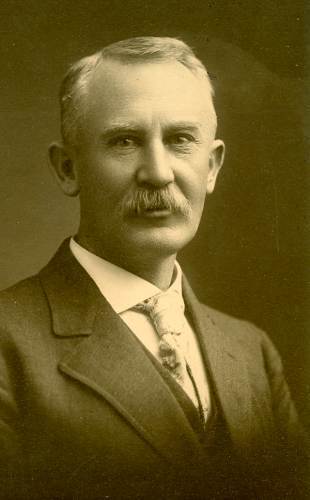
35a J.R. Wells Portrait
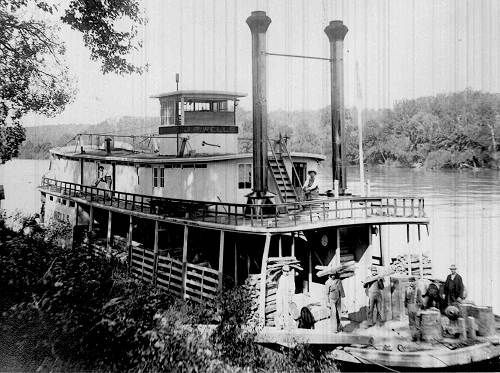
35b J.R. Wells Steamboat The other day I was visiting Roy and Joyce at their home in Jefferson City where I copied some old photos of the home taken in the early part of the last century. Here are two photos of the exterior of the home taken around the turn of the last century (photos 36 and 37):
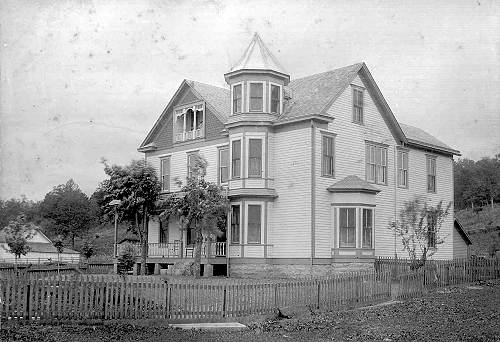
36 J.R. Wells Home - 1902
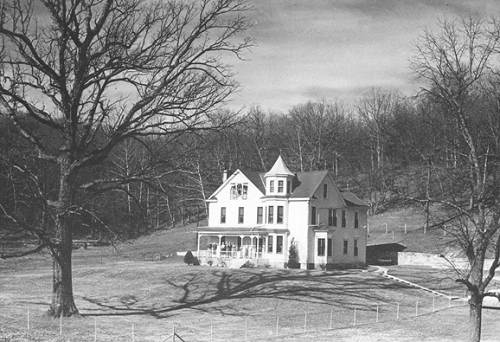
37 Wells Farm Home - 1940's The following are old black and white photos but they are interesting as they reveal some of the ornate woodwork in the home and the specially made furniture. Much of the furniture had been shipped up the Osage River by steamboat. The photos are presented without any specific comment (photos 38 thru 47):
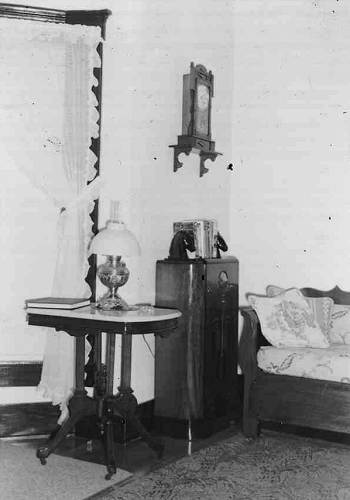
38 Inside the Wells Home
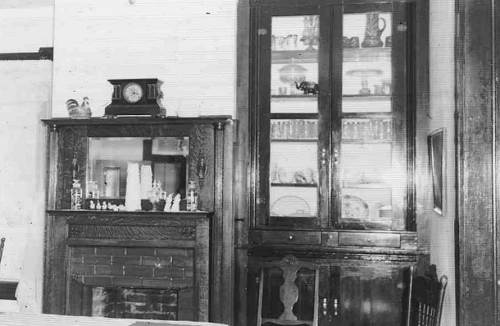
39 Inside the Wells Home
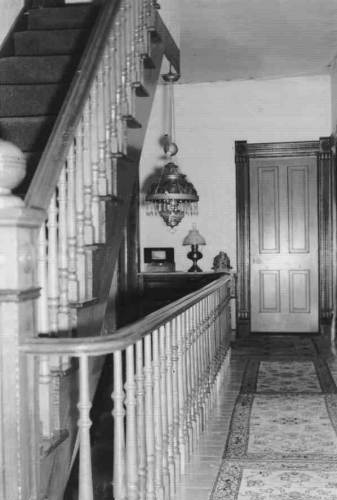
40 Inside the Wells Home
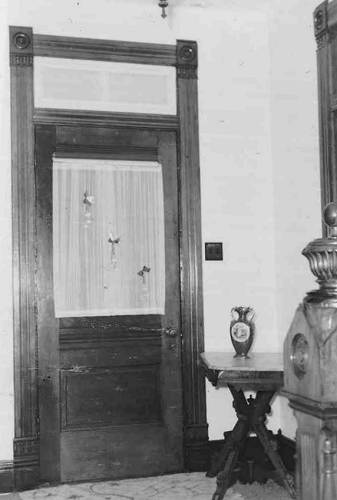
41 Inside the Wells Home
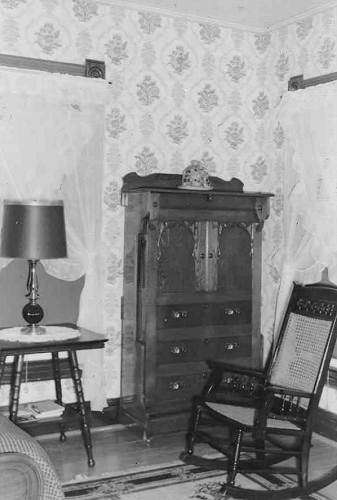
42 Inside the Wells Home
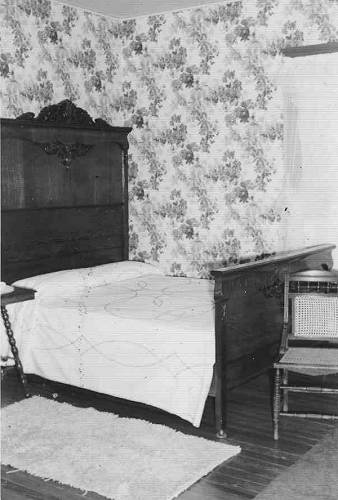
43 Inside the Wells Home

44 Inside the Wells Home
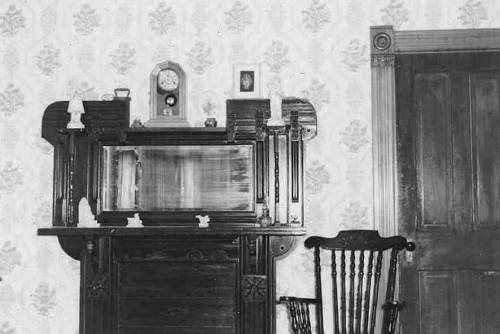
45 Inside the Wells Home
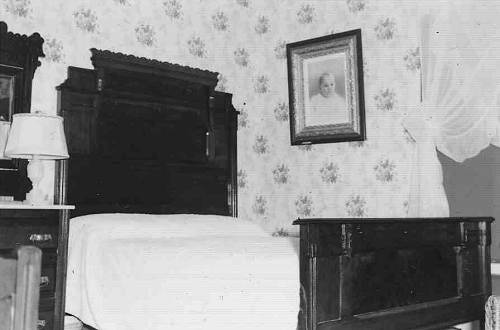
46 Inside the Wells Home
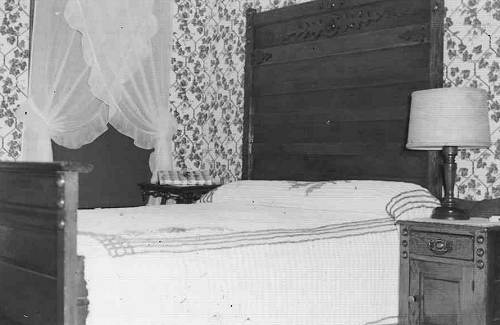
47 Inside the Wells Home
We frequently receive visitors from many parts of the country who come to our museum specifically for the purpose of doing genealogical research.
The other day we were delighted by the visit of sisters Judy Tayor of Colorado and Linda Packard of Maine who were researching several of their Miller County ancestors including the names of Wright, Bowden and Roberts (photo 48).
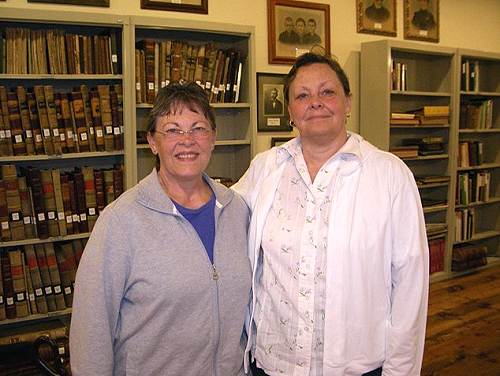
48 Judy Taylor and Linda Packard They reported they had direct heritage from the James Lawrence Wright family, one of the families significantly involved with the Anchor Milling Company whose old hardware store building presently houses our museum.
And here is your own special invitation to the Grand Re-Opening May 16 (photo 49):

49 Grand Re-Opening Invitation That's all for this week.
 Joe Pryor
|



